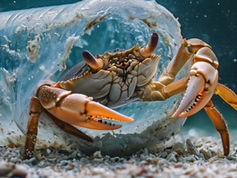Search
The Mysterious Life of a Jellyfish
- Lauren A. Moe

- Jan 4, 2023
- 4 min read
Updated: Jul 7, 2023
Jellyfish are truly mesmerizing animals. Their appearance alone is enough to let us imagine they grabbed some stardust, flew down from space, and made a home right in our oceans. Jellyfish are among a handful of marine animals that don’t have a brain; other notable species include starfish, sea cucumbers, coral, and sea urchins. But how do they grow and survive without a brain? We’ll get into that in just a minute.
All true jellyfish belong to the same class (Scyphozoa), and therefore share many similarities. Living solely in the ocean, these animals contain stinging cells (cnidocytes) that unlucky swimmers may already know about. They also show a unique form of symmetry. Most animals including humans have bilateral symmetry, which means that the left side of the body is externally the same as the right side. The way a butterfly has two sets of wings coming out of their body center tells us that they exhibit bilateral symmetry. Asymmetry is when an animal (namely sponges) has no center for symmetry to form. Jellyfish are radially symmetrical, meaning they have a center with similar parts surrounding it.

Image Source: OER Commons
A brain is a complex organ connected to a spinal cord, which makes up the central nervous system of an animal. Billions of nerve cells communicate within the brain which allow bodies to function, so how do jellyfish survive without one? While they do lack a centralized brain, they have a radially (remember the symmetry?) distributed nervous system throughout their body, rather than protected in a single area. All true jellyfish contain the same major components of this system: the rhopalium and the nerve net.
The rhopalium exist around the top bell part of jellyfish. It allows these animals to control their swim rhythm, feel gravity, and sense light. The nerve net controls the muscles and extend through the tentacles. It follows the swim rhythm to physically move jellyfish through the water and allow them to turn. When jellyfish sting other animals, they don’t go through the thought process of “hey, this guy sure is bugging me!”; the stinging cells, or cnidocytes, on their tentacles do that for them. When something brushes against a cnidocyte, the cell opens up and the tiny needle-like stinger shoots out. When it lands, venom is released. The nervous system of jellyfish is more complex than many imagine and allows for unexpected behavior from animals without a brain. Jellyfish have been seen escaping contact with predators, completing vertical migration, avoiding areas with low salinity, and using sun compass navigation by orienting themselves at the water’s surface based on the position of the sun.
Jellyfish go through two main stages of life: the polyp stage and the medusa stage. The polyp stage is nonmoving; they attach to hard surfaces in coastal reefs where they will spend their early life growing. During this time, they resemble tiny anemones only a few centimeters long and use their tentacles to capture prey. Polyp forms of jellyfish are able to reproduce asexually (without a mate) by budding, as seen in the bottom of the graphic shown below. The clones that form from budding will break away when conditions are right to become a free moving ephyra, which grow into jellyfish in the medusa stage- what we traditionally think of when we hear the term “jellyfish”. This stage requires both egg and sperm to reproduce, and the cycle begins again.

Image Source: Bruce Mahalski via The Encyclopedia of New Zealand








Comentários